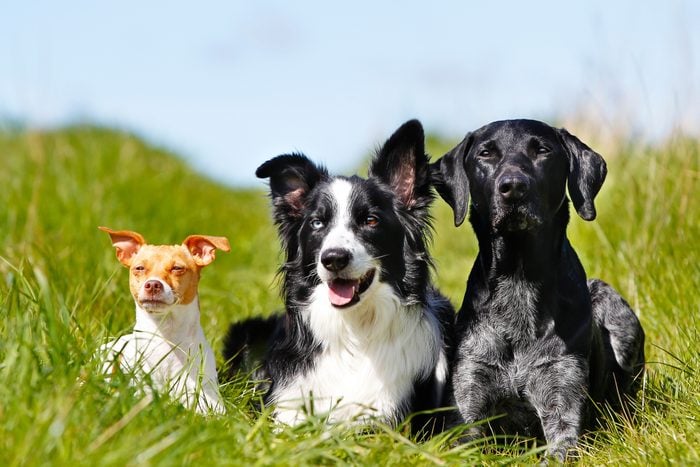
Dog myths are everywhere
You may think your dog knowledge is outstanding (you know popular dog breeds like the back of your hand), but the truth is that some dog facts you’ve heard through the grapevine simply aren’t that true. That’s right. There’s a lot of misinformation out there about our pups. And while much of it’s pretty harmless, some perpetuated dog myths are downright dangerous—for you and your dog.
Some inaccurate beliefs can cause you to misinterpret certain dog behaviors or dog facial expressions, lead to subpar nutrition or put a strain on the owner-dog bond. We reached out to a range of pet experts, including veterinarians, dog trainers and behaviorists, to shine some light on the biggest dog myths out there. Are those signs your dog is happy incorrect? Can you actually interpret the things your dog wishes you knew? Get to the bottom of these dog myths and facts.
Get Reader’s Digest’s Read Up newsletter for more fun facts, humor, cleaning, travel and tech all week long.
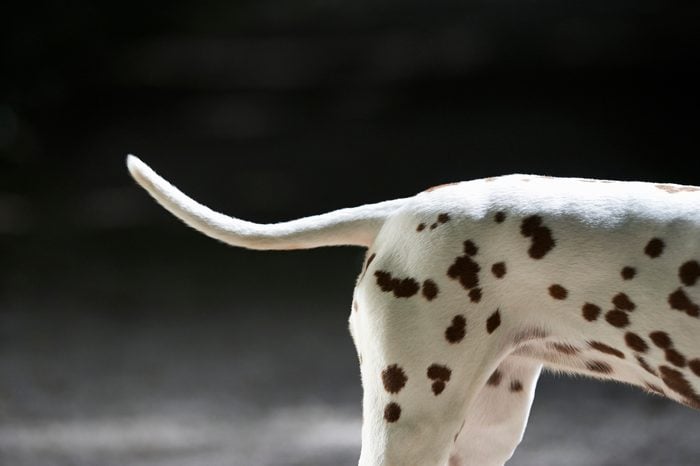
A wagging tail always means a happy dog
Have you wondered what your dog’s tail is telling you? Tail wagging is just one of the ways dogs communicate. And although a wagging tail often does denote an excited or happy dog, that’s not always the case. “For example, a vigorous tail wag to the right means happiness at seeing its owner, but slow wags of a tail held halfway down can mean fear or insecurity,” says Jess Trimble, DVM, chief veterinary officer for Fuzzy Pet Health. “Additionally, a tail held very high and wagged extremely fast can mean fear or aggression for some dogs.”
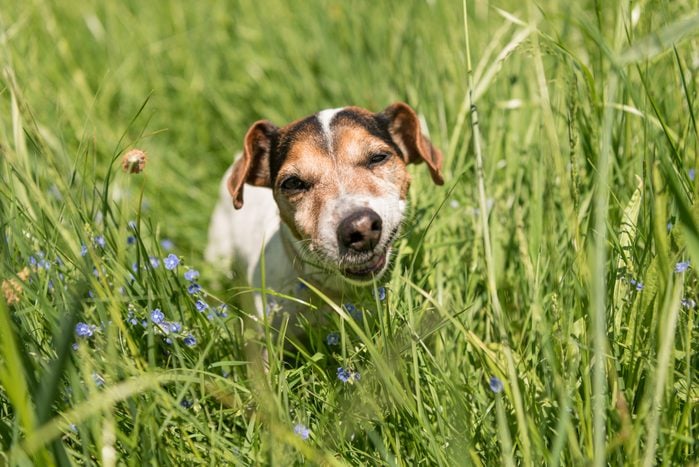
Dogs eat grass because they’re feeling sick
You might have noticed your favorite canine buddy likes to chomp on grass once in a while. They might even go straight for the patch of green the second they’re outside. One of the most common dog myths is that eating grass is a sign your dog is sick, but that’s not necessarily true. “So many clients come to me worried when their dog eats grass that they may be coming down with a sickness. This is not completely untrue, because the grass does act as a natural antacid to help make your dog’s belly feel better,” says Lindsay Butzer, DVM, a veterinarian and PetMeds partner. However, dogs eat grass for many reasons, some of which have nothing to do with an upset stomach. “They might just like the taste of the grass,” Dr. Butzer says, “or they are still hungry and want to keep eating, and the fibrous grass will fill them up.”
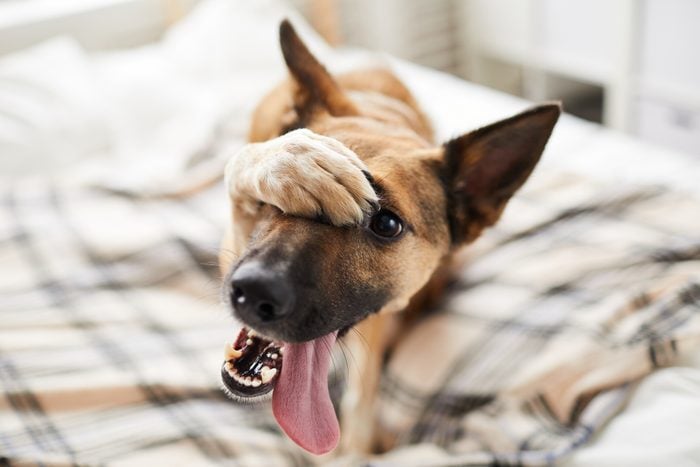
You can’t teach an old dog new tricks
You’ve heard this phrase before (or maybe you’ve seen it on the best gifts for dog lovers): “You can’t teach an old dog new tricks.” And while it is true that puppies are like sponges, making it so easy to teach them new things, “make no mistake, old dogs can learn too,” says Trish McMillan, a certified animal behaviorist. “For example, the 9-year-old Doberman I adopted a few years ago earned her Canine Good Citizen title [from the American Kennel Club] within a few months.” McMillan notes that some geriatric dogs that struggle with vision, hearing or mobility issues may not be as easy to train. However, as long as their brain is in good shape, they can absolutely learn new things. Here are some fun and easy tricks to teach your dog.
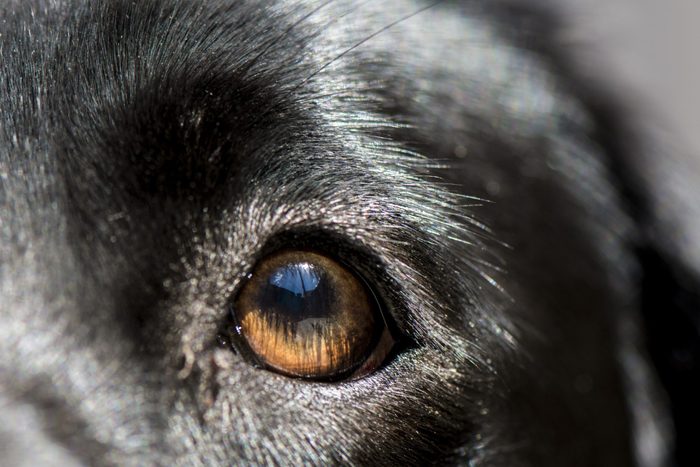
Dogs only see in black and white
Dogs really do have a mind of their own—these are the things dogs think about during the day. But they also have eyes of their own and other senses they rely on. And the idea that they only see in black and white is arguably one of the most perpetuated dog myths out there. Dogs can in fact see some color, but the spectrum is limited, says Adam Christman, DVM, chief veterinary officer for dvm360. “Humans and most other primates have three kinds of cones in our eyes, making us trichromatic; dogs are bichromatic.” And because of this, they do have a tendency to mix up greens and reds.

Garlic is a natural flea and tick remedy
When your dog is dealing with fleas or ticks, you’ll likely do anything to give them (and your household) some much-needed relief. If you’ve read that garlic acts as a natural cure, don’t believe it. Garlic is actually toxic to dogs and one of the foods dogs can’t eat, so you’ll want to keep it away from your pup.
“Garlic will not only have zero effect on fighting off fleas and ticks, but it can also lead to a serious disease known as Immune Mediated Hemolytic Anemia (IMHA),” says Michelle Dulake, DVM, veterinarian and founder of Fera Pet Organics. “Even though it is a rare disease, IMHA causes the body to destroy its own red blood cells, leading to life-threatening anemia. By feeding garlic, you are unnecessarily risking your pup’s health, expensive hospital bills and multiple blood transfusions.”
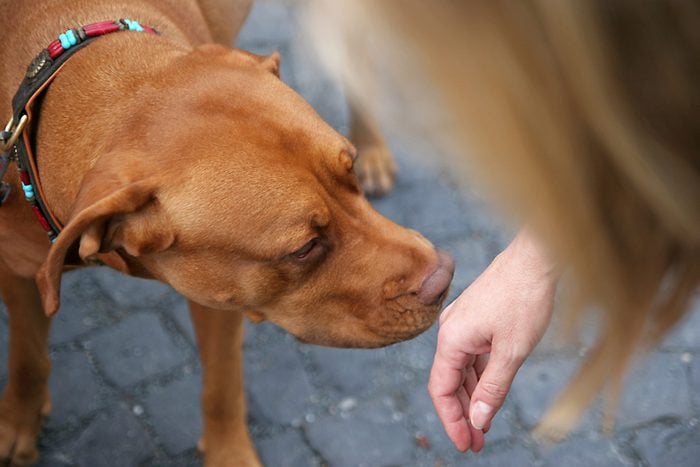
If you meet a dog, let it sniff your hand
This is a well-intentioned line of thinking, but a perpetuated dog myth nonetheless. In actuality, you should not stick your hand out toward any dog you’ve just met. “In our human interactions, it’s second nature to offer a handshake or a fist bump, but we must remember that dogs aren’t humans,” says Guillermo Roa, a credentialed dog trainer and founder of GR Pet Services. “Sticking out your hand can be misinterpreted as a sign of aggression, and a dog may bite you.” Roa says it’s better to calmly wait for the dog to approach you, if it is interested in doing so. You don’t know about the dog’s obedience record, after all. So if you must approach a new dog, do it from the side and avoid making intense eye contact.

One dog year equals seven human years
Although dogs do age quicker than humans, the seven-to-one ratio isn’t quite accurate. Their comparative age depends entirely on breed (whether they’re one of the healthiest dog breeds), size and genetic makeup, says Dr. Trimble. “The bigger your dog is, the faster they age. I have patients that are 10-pound terriers that still act like puppies at 16 years old and would be considered around 75 to 80 in human years. In contrast, a Great Dane at 16 would be a record and considered to be more than 130 years of age.”
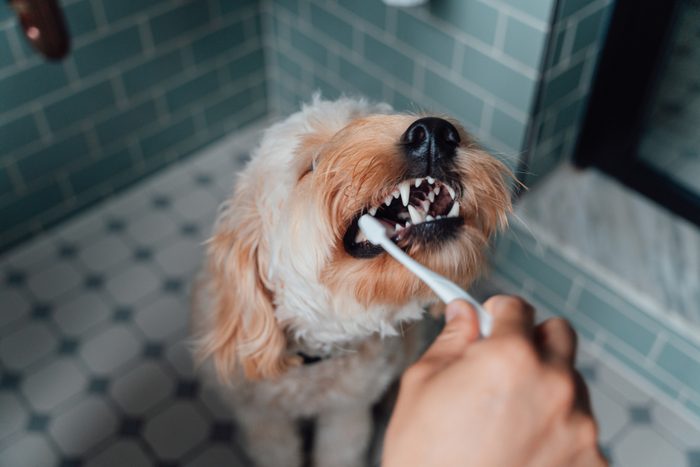
Bad dog breath is completely normal
Bad dog breath is so common that most people think it’s just something dog parents live with. The truth is that your dog’s breath really shouldn’t be that bad—and you should be brushing your dog’s teeth more often than you think. “Your dog will never have minty-fresh breath, but it shouldn’t be unbearable either,” says Tim Vogel, professional dog groomer and CEO of Scenthound.
“Bad breath is an indicator of underlying health issues. Specifically, chronic bad breath is caused by bacteria in the mouth and is often the first sign of dental disease.” In fact, Vogel says the biggest culprit of bad dog breath is periodontal disease, which affects up to 80% of dogs by age 3. In addition to tooth loss, abscesses and periodontal disease, poor oral hygiene can lead to life-threatening conditions, including kidney, liver and heart damage.
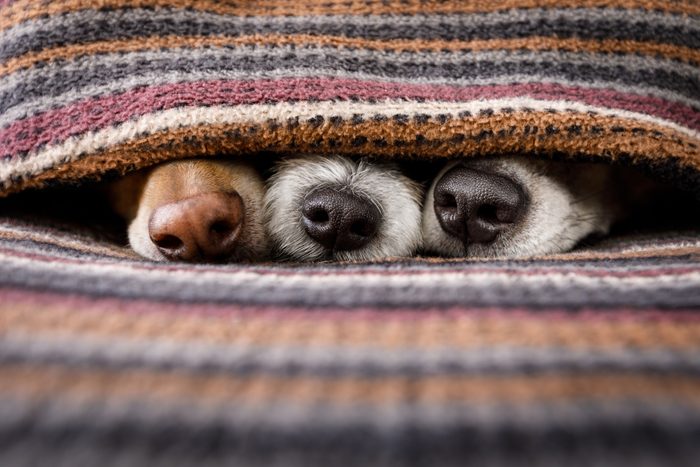
A warm and dry nose means your dog is sick
One of the most repeated dog myths out there is about dog illness symptoms and implies that a healthy dog’s nose is always cold and wet. Warm and dry noses are completely normal though, so don’t worry if this is the usual state of your dog’s snout. “Everything from dry air and allergies to simply taking a nap can affect the wetness of your dog’s nose,” says Dr. Christman. “However, while nose health isn’t normally concerning, if you notice your pet’s nose is constantly dry, cracking or running—not simply wet—then you should make an appointment with the veterinarian.”

Always spay or neuter at a young age
“Spaying and neutering dogs at a young age was happening at an alarming rate several years ago, and many veterinarians took the stance of ‘the younger, the better,'” says Adam Gibson, a dog trainer and director of Top Dog Texas. The idea is that early neutering or spaying will curb behavioral issues as the pet gets older, but it might actually be a mistake dog owners are making. Gibson points out that numerous studies have shown this to be untrue and waiting to neuter your dog may be safer in the long run. “There are also added health benefits to allowing dogs to keep their reproductive organs intact into adulthood,” Gibson says. The community is responding to this new data, and more vets and owners are waiting six months to one year to spay or neuter pups.

Use dog treats to bribe your pet
Sure, they taste good, and your dog might beg for them, but the best dog treats aren’t just a way to bribe your pet into following your orders. The best dog trainers view treats as rewards—not bribes. “Treats are a really great way to show your dog that their consistent good behavior or listening is going to be positively reinforced with a reward,” says Nick Navarro, a professional dog trainer and co-owner of K9 Concepts.
“When we’re training our dogs’ behaviors, we want to consider when we are giving them their treats. If you’re giving them treats before a bad behavior happens, that would be considered a bribe. However, after they do something good—like dropping something they shouldn’t be chewing on or coming when called—you should definitely be digging into that treat jar for a job well done.” Bottom line: Treats (store-bought and homemade dog treats) are an excellent training tool for young dogs. Combine it with other training methods, and you’ll have an all-star pup in no time.
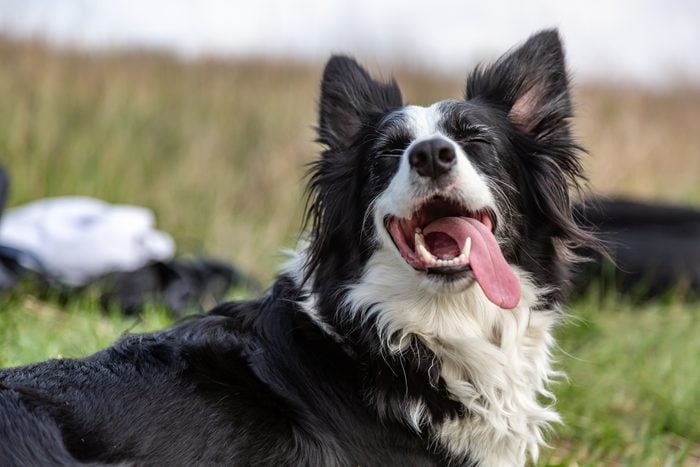
A dog’s mouth is cleaner than a human’s
This is one of the most common dog myths vets encounter. If a dog’s saliva was as antibacterial as the myth states, they’d be walking medical superheroes. Sure, dogs are superheroes in their own right, but this is one dog myth we’ve got to put to rest. “While dog saliva has a slightly more alkaline pH, which can discourage some bacteria from reproducing, it’s not truly antibacterial,” says Dr. Trimble. “In fact, as a vet, one of the most common causes of canine skin infections we see is from a dog licking a wound or itchy spot too much.” Learning how to clean your dog’s teeth properly is vital to improving their oral health and preventing disease.
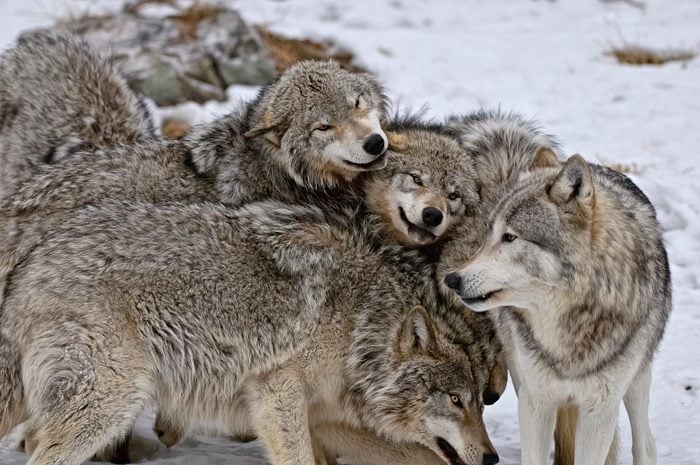
Dogs evolved from wolves and should eat like them
Dogs and wolves may come from the same lineage (in fact, these wolf dog breeds make great additions to your family pack), but treating them as an interchangeable species is not ideal and can even impact their health. Dogs evolved from wolves more than 11,000 years ago, says Dr. Trimble, and over that evolution, they’ve become two entirely different creatures. “Dogs should not eat the wild-wolf-type diet that’s becoming popular by boutique pet food manufacturers,” she says. So what should your dog eat? These are the best dog food brands that vets swear by.
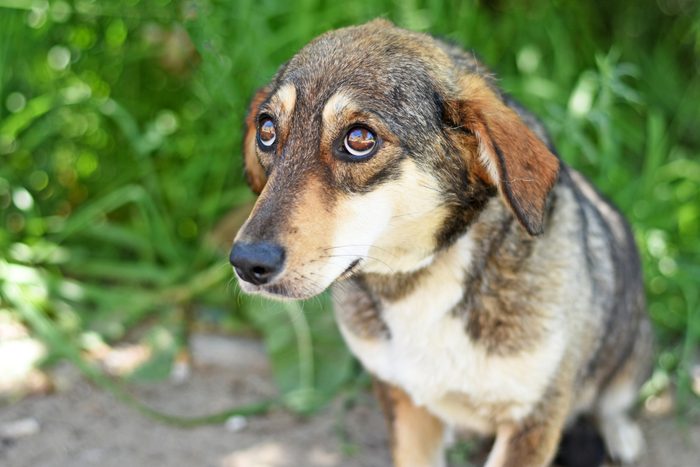
It’s important to show your dominance
Known as the alpha wolf theory, McMillan explains that it became a popular dog training method after wolves were first studied in captivity. However, with time, we’ve learned that dominance isn’t necessarily the best approach. “Later studies of wild wolves showed that packs are just families, with the older wolves caring for and teaching the younger ones until they’re old enough to leave,” McMillan says.
“Modern dog trainers use behavioral principles to look at the antecedents and consequences of behavior, managing the environment, meeting dogs’ needs for social time, enrichment and exercise, and teaching dogs what we want them to do, rather than solely punishing them when they misbehave.”

Rubbing your dog’s nose in an accident curbs future behavior
This is one of those dog training myths that does more harm than good. Because dogs tend to understand behavioral problems at the time the behavior occurs, rubbing your dog’s nose in an accident when you come home and find it likely will not help them make the connection. “When you do this, you’re in essence punishing a dog that doesn’t know why it’s being punished. This could exacerbate the issue and create more problems in the future,” warns Dr. Christman. “Rather, it’s best to catch them in the act and redirect them to their proper potty destination.” Need help house training? Try the best washable dog pee pads, and be sure to clean up accidents with a pet-friendly cleaner, since dogs often return to spots they’ve previously marked.
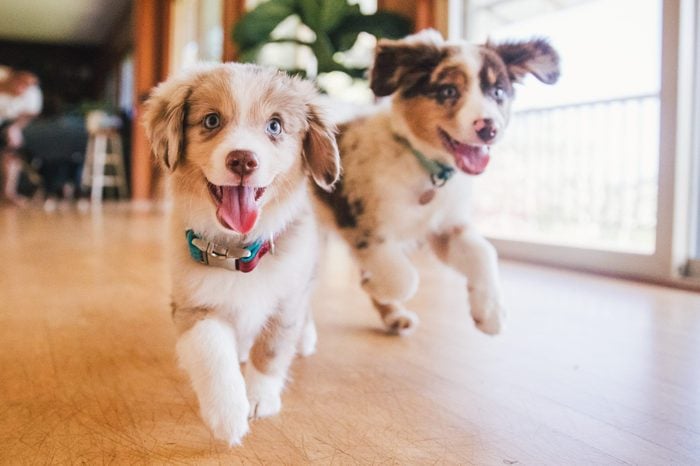
Two puppies at once is best (they’ll have a playmate)
Adopting two puppies at once sounds like a perfectly reasonable approach—and one that promises countless adorable puppy pictures. But it’s one of those dog myths that may lead to headaches all around, warns Gibson. Think of all those dog zoomies! “From a training and behavioral standpoint, the biggest issues I see with two young puppies being raised together are that they end up being much harder to train,” he says. Even if they are the easiest dog breeds to train, “they are oftentimes so co-dependent upon each other that they don’t seem to develop nearly as much as a puppy raised appropriately by itself.” Additionally, Gibson says they tend to be distracted by each other, and because their bond is so strong, they tend to place less value on their human relationships.
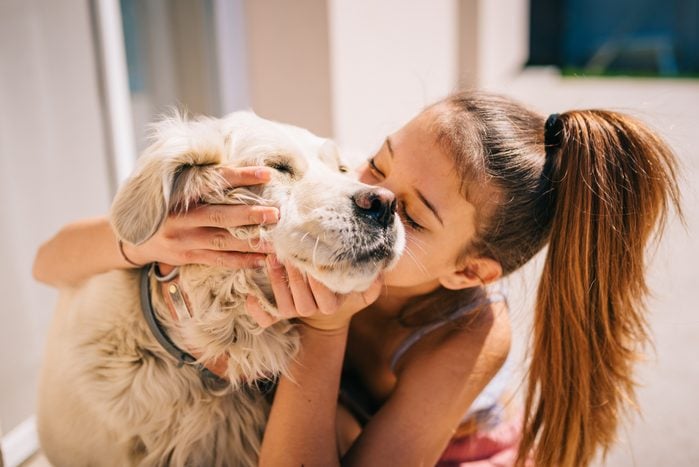
The more love, the better the dog
What do dogs want? If your answer is love, you’re only partially right. Love is important when it comes to fostering a healthy relationship with your pup and training them well, but don’t confuse love with poor boundaries. “Pets are increasingly seen as part of the family, and that can be wonderful,” says Roa. “We often want to indulge them by giving them the comfiest seat in the house or food from the table, but that can backfire. Like human children, furry kids require boundaries. Without boundaries, you will end up with many behavioral issues that can include aggression.” Dogs don’t think that humans are dogs, which means boundaries set by humans are beneficial. For Roa, gentle guidance and redirection are vital to establish a mutually respectful bond that benefits both pets and their humans.

Dogs yawn when they’re tired
Dogs are highly emotional, and it affects their behaviors—have you ever wondered why dogs sigh? If you catch your dog mid-yawn, you might just assume it’s feeling sleepy and ready for a nap. That’s a reason humans yawn, after all. But not so fast! Yawning is common in dogs, and while they may yawn when they are tired, Dr. Butzer says dogs also yawn due to boredom, anxiety, stress or when they want to get away with something. “For example, my dog will yawn when she has to sit still on the couch while we are eating dinner in the dining room. Dogs will also yawn during a veterinary visit due to stress or wanting to leave the appointment.”
If you notice you have a bored dog, remember that doggy doldrums can actually lead to behavioral issues. Keep them engaged, relieve stress and more with these brain games for dogs.
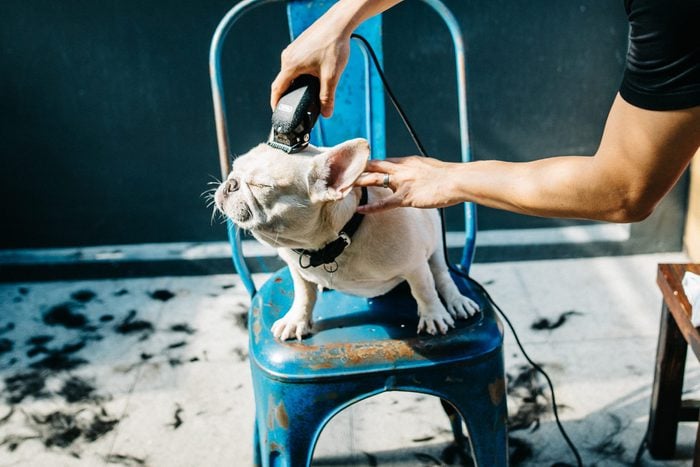
Short-haired dogs don’t need grooming
When people think of dog grooming, they often think of haircuts. So it’s easy to assume that only long-haired dogs would need routine maintenance. But that’s one of those dog myths that’s bad for their health. The reality is that whether you choose to see a professional or groom your dog at home, every dog requires grooming to maintain good health. “All dogs need routine care, like bathing, ear cleaning, nail clipping and teeth brushing, to stay clean, comfortable and healthy,” says Vogel. “For example, long nails aren’t just unattractive or noisy—they can affect your dog’s overall health and comfort.” Routine ear checks and cleaning can ensure your dog is free of parasites, while brushing and bathing removes loose hair and dander. “Basic hygiene and grooming services aren’t luxuries reserved for special occasions; they’re imperative to maintaining your dog’s overall health and wellness.”
Sources:
- Jess Trimble, DVM, chief veterinary officer for Fuzzy Pet Health
- Lindsay Butzer, DVM, veterinarian and PetMeds partner
- Trish McMillan, certified animal behaviorist
- Adam Christman, DVM, chief veterinary officer for dvm360
- Leading Edge of Medicine: “Vision in Dogs”
- ASPCA: Garlic
- Michelle Dulake, DVM, veterinarian and founder of Fera Pet Organics
- Guillermo Roa, credentialed dog trainer and founder of GR Pet Services
- Tim Vogel, professional dog groomer and CEO of Scenthound
- Adam Gibson, dog trainer and director of Top Dog Texas
- Frontiers in Veterinary Science: “Assisting Decision-Making on Age of Neutering for 35 Breeds of Dogs: Associated Joint Disorders, Cancers, and Urinary Incontinence”
- Nick Navarro, professional dog trainer and co-owner of K9 Concepts
